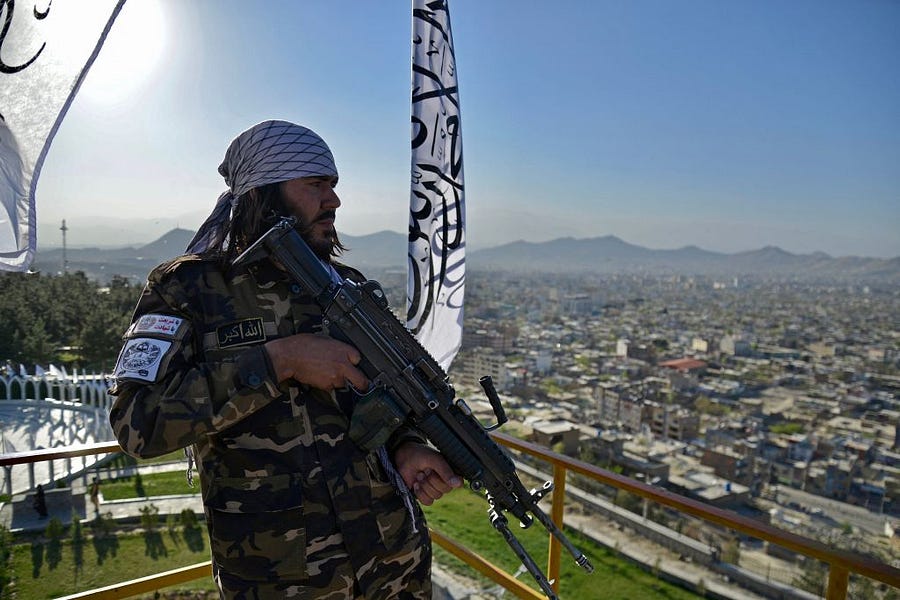As hundreds of worshippers congregated for Friday prayers in Peshawar, Pakistan, on the afternoon of March 5, a man under the alias Julaibeed al-Kabuli entered the Shiite service, opened fire, and detonated what local authorities later assessed to be a vest containing more than 11 pounds of TNT packed with ball bearings. The attack killed more than 60 people and wounded 194 others, becoming Pakistan’s deadliest suicide bombing since 2018.
The assailant and his jihadist backer—the Islamic State Khorasan (ISIS-K)—both hailed from neighboring Afghanistan, where militant groups have continued to expand their ranks, train new recruits, and plan attacks in the region since the Taliban’s takeover last summer. And their reach is likely to grow in the near future. The Pentagon’s third-ranking civilian, Colin Kahl, testified in October that both ISIS-K and al-Qaeda intend to conduct “external operations,” including against the United States. The former may have that capability as soon as late April, Kahl said, and the latter as soon as October.
It’s against the backdrop of this growing threat that the U.S. is now without real surveillance or military capabilities in Afghanistan following its withdrawal last summer. Testimony from high-ranking Pentagon officials last week revealed that the U.S. has not conducted a single counterterrorism strike in Afghanistan since the final C-17 aircraft departed Kabul on August 30.
As Afghanistan watchers predicted at the time of the drawdown, the Biden administration’s plan to continue “over-the-horizon” military and reconnaissance operations from afar has proven deficient. Limiting factors, including logistical issues like refueling and accessing launch sites in neighboring countries, undoubtedly play a role. But the failure of over-the-horizon operations isn’t the only disconnect between President Joe Biden’s declaration last summer that the war was over and the on-the-ground realities in the months since.
While August 30 marked an end to the U.S. military presence in Afghanistan, the Taliban’s war on the country’s civilian population has waged on, particularly against women, religious and ethnic minorities, former government officials and soldiers, and our abandoned Afghan allies. Far from being weakened, the Taliban’s bonds with American adversaries—from militant Islamist groups like al-Qaeda to global powers like China and Russia—have grown stronger by the day. And in the aftermath of the botched U.S. withdrawal, the sense of impunity among those same adversaries and new aggressors has grown.
In public statements justifying the rash drawdown, the Biden administration portrayed the U.S. presence in Afghanistan as a distraction from larger concerns. Without an expensive military footprint in Central Asia, the argument went, the U.S. military could better counter threats posed by strategic competition with China and hybrid warfare from Russia.
But asked by senators last week if the pullout may have influenced Russian President Vladimir Putin’s decision to invade Ukraine, Chairman of the Joint Chiefs of Staff Gen. Mark Milley conceded the possibility—something independent analysts have also assessed to be likely. According to Husain Haqqani, former Pakistani ambassador to the U.S. and current director for South & Central Asia at the Hudson Institute, the “demonstration effect” wrought by the abandonment of Afghanistan has both isolated allies and empowered adversaries in recent months.
“The Biden Administration’s expectation that a withdrawal from Afghanistan would have no other consequences has been proven wrong. The clumsy withdrawal from Afghanistan and the impression that the United States was retreating from the world definitely played a role in Putin’s power grab in Ukraine,” Haqqani said in an interview with The Dispatch. “China and Russia are playing a greater role in the matters of Afghanistan, which also means that they end up having a greater influence on Pakistan—a nuclear armed country. America’s influence in Central Asia has declined.”
Both Russia and China moved quickly to capitalize on the power vacuum the U.S. pullout created, establishing diplomatic and economic relations with the interim Taliban-led government (though they’ve both stopped short of offering formal recognition).
Last week, Russia became the most recent country to forge diplomatic ties with the extremist group, formally recognizing the Taliban envoy in Moscow, Jamal Nasir Garwal, as “Afghan Charge d’Affaires.”
And China’s Foreign Minister, Wang Yi, became the highest-ranking foreign official to visit Taliban-occupied Afghanistan with an impromptu visit to Kabul last month. In a lengthy description of Wang’s conversation with the Taliban-designated foreign minister, the Chinese foreign ministry touted China’s role in Afghanistan’s “development and revitalization,” claiming that the Taliban plans to “actively participate in Belt and Road cooperation and strengthen trade and investment cooperation with China.”
The Chinese venture will establish trade and infrastructure ties connecting Asia, Africa, and Europe, but it faces international scrutiny as a way for Beijing to exert undue influence on developing economies by saddling them with major debt.
Another readout from Wang’s trip alluded to China’s likely diplomatic recognition of Taliban-led Afghanistan: “China respects the independence, sovereignty and territorial integrity of Afghanistan, respects the independent choices made by the Afghan people, and respects the religious beliefs and national customs of Afghanistan. China never interfered in Afghanistan’s internal affairs, never seeks self-interests or the so-called spheres of influence in Afghanistan,” it read. “Wang Yi stressed, as Afghan friends often point out, China is the only major country that has never hurt Afghanistan.”
But the visit also served China’s vested interest in minimizing terrorism emanating from the country. Wang reportedly urged the Taliban not to offer safe haven to the East Turkestan Islamic Movement (ETIM), a Uyghur group and al-Qaeda affiliate reconstituting near Afghanistan’s 47-mile border with China. The Taliban has tried to degrade the group’s influence in the northeast Badakhshan region as it seeks financial backing from Beijing.
The “real threat” from Afghanistan in the coming years will be al-Qaeda and other groups operating with the Taliban’s approval, explained Bill Roggio, senior fellow at the Foundation for the Defense of Democracies and editor of its Long War Journal. “The Taliban is in full control of the country. There’s no organized resistance,” he told The Dispatch. “[Jihadist groups] now have access to training camps and can operate in an environment where they’re not being harassed.”
And the Pentagon is largely unable to target the growing cells or their leaders, given the lack of actionable intelligence coming out of Afghanistan. Gen. Kenneth F. McKenzie Jr., head of the U.S. Central Command, admitted as much in December, estimating Washington’s current view into the country to be about “1 to 2 percent” of its former monitoring capabilities. Without an in-country intelligence gathering apparatus, rooting out terrorist cells and their leaders becomes near-impossible. And just as China and Russia were encouraged by the botched U.S. evacuation from Kabul, so too were radical Islamist groups worldwide.
“The global Islamist extremists have definitely been empowered by the victory of the Taliban in Afghanistan. The narrative amongst the jihadists around the world is that we have defeated the Soviet Union, and now we have defeated the Americans. We are seeing a resurgence of terrorism everywhere. There will be spillover,” Haqqani said. “You can’t be a global leader with isolationist impulses. You can’t lead with weakness.”








Please note that we at The Dispatch hold ourselves, our work, and our commenters to a higher standard than other places on the internet. We welcome comments that foster genuine debate or discussion—including comments critical of us or our work—but responses that include ad hominem attacks on fellow Dispatch members or are intended to stoke fear and anger may be moderated.
You are currently using a limited time guest pass and do not have access to commenting. Consider subscribing to join the conversation.
With your membership, you only have the ability to comment on The Morning Dispatch articles. Consider upgrading to join the conversation everywhere.